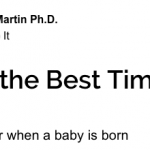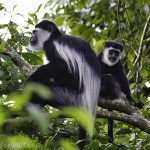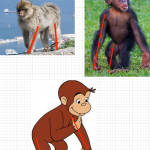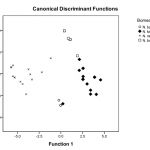primates
After, not before, you get to the hospital, I always say.
But seriously, Robert Martin, the famous primatologist, has an interesting piece in Psychology Today exploring this question. Go read it. I've got a few thoughts spurred by this research I'll list briefly here.
First, it seems that wild primates give birth during their daily down-time, the period of time that they are generally inactive. Dirunal primates do so more at night, nocturnal primates do so more during the day. Various reasons have been proposed. I've not read the primary literature on this, but in my ignorance I wanted to…
The Hot Zone was first released in 1994, the year I graduated high school. Like many readers, that book and Laurie Garrett's The Coming Plague* really sparked my interest in infectious diseases. In some sense, I have those books to thank (or blame?) for my career.
But I'm still going to criticize The Hot Zone, because as a mature infectious disease epidemiologist and a science communicator in the midst of the biggest Ebola outbreak in history, The Hot Zone is now one of the banes of my existence. A recent article noted that the book is back on the bestseller list, going as high as #7 on the…
Yes, yes, we hear it all the time: More CO2 is good because plants love CO2
That is a rather dumb thing to say for a number of reasons; nature is not simple. You don't change one variable and expect other variables to respond as though we were turning a garden hose up or down. For example, while plant growth might be enhanced with more CO2 in the atmosphere, there is no reason to think this would be linear, or similar across all plants. You have to dance with the one who brung ya. The plants we have are the plants that have been under Darwinian selection optimizing growth and maintenance…
Curious George is called a "little monkey" in all of the Curious George literature, TV shows, and movies. But Curious George has no tail, and generally, that means you are an ape. But, there is one monkey with no tail, or at least one that is vestigial and not visible: The Barbary Macaque (Macaca sylvanus). For this reason, some have suggested that George is a monkey, specificaly, a Barbary Macaque or perhaps a close previously undiscovered species.
However, one of the main features distinguishing between monkeys and apes is the intermembral index. This is simply the relative proportion…
The Slow Loris (Genus Nycticebus) is a category of prosimian (primates that are neither monkey or ape) that lives in southeast Asia. Most prosimian species live on the island of Madagascar, but there are several African and Asian forms, all of which are nocturnal. The Slow Loris is special because it is the only primate we know of that has a toxic bite.
The total number of nocturnal primates known has increased considerably over the years and I'd wager there are many more to be found. “Technological advances have improved our knowledge about the diversity of several nocturnal mammals,”…
I discuss the topic of emerging infectious diseases today over at Slate, as part of their Pandemic series.
Nature is a potential source of guidance for our behavior, morals, ethics, and other more mundane decisions such as how to build an airplane and what to eat for breakfast. When it comes to airplanes, you'd better be a servant to the rules of nature or the airplane will go splat. When it comes to breakfast, it has been shown that knowing about our evolutionary history can at times be a more efficacious guide to good nutrition than the research employed by the FDA, but you can live without this approach. Nature works when it comes to behavior too, but there are consequences. You probably…
The term "Dunbar's Number" refers to a particular hypothesis by primatologist Robin Dunbar. It is a very simple idea with rather complex implications, and it is one of those simple ideas that gets more complicated than ideal as we look into it more and more. Eventually, the idea is required by many who contemplate it to do more work than was ever intended, and in this way seems to fail, though it really doesn't. I personally think Dunbar's number is useful if it is properly understood, so I want you to give it a chance, and to help you do that I'd like to use an analogy.
I'm thinking of a…
We three had somehow wound our way down into the canyon without experiencing any really steep slopes, but having walked for several miles in the sandy dry riverbed, Trusted Companion, Young One, and I were now looking rather hopelessly at unsafe-to-climb cliffs on both sides, covered with imposing vegetation of the kind that sports a thorn every few inches. The sun was low enough that the canyon floor was in a dark shadow, and the air was beginning to chill down. We were far enough from the vehicle, lost enough, and sufficiently plan-free that it would be perfectly reasonable to worry that…
On the Move: How and Why Animals Travel in Groups, edited by Sue Boinski and Paul Garber is a compendium of academic research on ... well, on how and why animals travel in groups. Notice of this book is a fitting start to a series of reviews of migration-related books that is part of Migration Week on GLB. (For an overview of the Bigness and Vastness of bird migration in particular, see A Question of Migration.)
Group movement is only rarely migration, though the two phenomena are overlapping subsets. An example of group movement that demands some explanation is that found in chimpanzees…
With never-before-seen video, primatologist Isabel Behncke Izquierdo (a TED Fellow) shows how bonobo ape society learns from constantly playing -- solo, with friends, even as a prelude to sex. Indeed, play appears to be the bonobos' key to problem-solving and avoiding conflict. If it works for our close cousins, why not for us?
I know Marc Hauser, and I trust him. I worked with him for a few years as a colleague on the faculty in the Anthropology department on various administrative matters (such as graduate admission and undergraduate program development) and we taught together. We are very different kinds of people, and did not always see eye to eye (well, we disagreed on one thing, once), but the same can be said of almost any two people from those days and that department, to some degree.
I've just heard about the "investigation" into his lab and the retraction of, so far, one paper produced in that lab…
The newly reported Saadanius hijazensis may or may not be a "missing link" but in order for this monkey to climb onto the primate family tree, a new branch had to be sprouted. So, not only is Saadanius hijazensis a new species, but it is a member of a new taxonomic Family, Saadaniidae, which in turn is a member of a new Superfamily, Saadanioidea. Why is this important? It's complicated. But not too complicated.
The fossil was found while University of Michigan paleontologist Iyad Zalmout was busy looking for dinosaur fossils in western Saudi Arabia. He found the monkey, from a much…
In Robert Gardner's documentary film Dead Birds, the men of a highland New Guinea village guard the perimeter of the territory, watchful for men of the neighboring group who may be intent on sneaking into the gardens to capture and kill an unwitting child or woman in order to avenge a prior death. But they don't see the men sneaking through the dense riparian forest. They don't even look for them. Rather, they see the birds fly from their preferred habitat where they are foraging or resting, startled into the open by ... something. The birds belie the predator.
Today, in construction…
Laurie Santos looks for the roots of human irrationality by watching the way our primate relatives make decisions. A clever series of experiments in "monkeynomics" shows that some of the silly choices we make, monkeys make too.
Remember Evolutionary Psychology? The theory?
It's over.
I think I've told the story elsewhere of having been at the birth of Evolutionary Psychology, down in room 14A in the Peabody Museum. If not, remind me some time and I'll tell it.
Evolutionary Psychology is a particular theory of how the mind works, how evolution has shaped that mind in certain predictable and testable ways, bla di bla di bla and so on and so forth. And, although there is something in there ... something in that theory ... that is useful, it is mostly not really very close to what happens when humans behave. Or…
Is it a Falsehood that Humans Evolve from Apes?
How about this one: Is it a Falsehood that Humans did NOT evolve from Apes????
Yes and no. Humans descend from a population of primates from which other apes also descended (minimally the two species of living chimps) and which was part of the panoply of late Miocene forms, all related to each other, that we call apes. So yes, humans evolved from apes.
There are people who don't believe that. They, creationists, think that apes are apes and humans came from somewhere else, like the Garden of Eden or Mud or whatever. (This may depend on…
What rights should be afforded non-human animals, to which animals, under what circumstances, and why? What are the criteria for such decisions? What should those who disagree with the status quo do?
In my view, some rights should be given to some animals, depending on circumstances. I believe the criteria for this decision are more arbitrary than one might think, but a phylogenetic (anthrocentric) model is arguably useful for some, but not all decisions. Individuals involved in the discussion often inappropriately characterize the positions of others at the expense of reaching some kind…
An assortment of tree-living mammals
In The Descent of Man, Darwin talked about the benefits of life among the treetops, citing the "power of quickly climbing trees, so as to escape from enemies". Around 140 years later, these benefits have been confirmed by Milena Shattuck and Scott Williams from the University of Illinois.
By looking at 776 species of mammals, they have found that on average, tree-dwellers live longer than their similarly sized land-lubbing counterparts. Animals that spend only part of their time in trees have lifespans that either lie somewhere between the two extremes or…
I had mentioned earlier that the volcanoes of the Virugna region in the Western Rift Valley (as well as other highland spots) have often been islands of rain forest separated from each other by different habitats, including grasslands and wooded savannas. this has produced an island effect that has been a laboratory for evolution, and it is likely that these forest islands (and others in the greater region of east Central Africa and western East Africa) have been the loci of evolution of many endemic species. (See Island Africa: The Evolution of Africa's Rare Animals and Plants by Kingdon…



